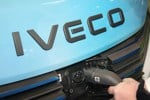You know when you are getting old because the science fiction of your childhood becomes the reality of the present.
I had that strange feeling of the past and future colliding with General Motors' brilliant Hy-wire. In many ways it resembles the wooshing plastic oblong vehicles of 1970's television shows such as Buck Rogers and Logan's Run – although it looks like nothing I have ever driven before.
But it is not some fanciful peek into a theoretical future. This is deadly serious and the fact that GM has spent more than £3 million building it over the past eight months explains the intent behind the project.
The minute you get close to the Hy-wire, the application and thought put into it becomes apparent, from the 22-inch rear wheels to the silvery buttons which activate the gearbox and the rear cameras replacing the traditional mirrors.
##Hywire--none--The GM Hy-wire##
The five-metre long exterior was styled by Bertone and is swathed in glass because the most noticeable part is the clear panel where a radiator would be on a conventional car. The powertrain, fuel cells and electronics are hidden away in the 11-inch thick 'skateboard' chassis. So look down past your feet and you can watch the road passing underneath. Alan Nicole, exterior designer for Hy-wire, said: 'We decided to enclose it with glass, allowing the driver to have a view of the road ahead that has never been possible before.'
The lack of a conventional engine means lots of space, and limousine-like levels of legroom in the front and back for the stressed executive of the future to stretch out in. The cabin is attached to the skateboard by 10 locking points and the docking port for the steering module which, the designers say, means that in the future, changing bodyshells to suit an owner's mood is a distinct possibility.
In fact, according to GM executive director of design Ed Welburn, this simple way of swapping shells could inspire a whole new generation of specialist independent coachbuilders.
I was one of the first people in the world to get the chance to drive the Hy-wire, at a launch near Monaco, and controlling it was a daunting prospect. It would be intimidating enough driving millions of pounds' worth of vehicle with standard controls, but with the system used in the Hy-wire – an entirely new way of controlling speed and direction – it was downright frightening.
The driver control unit looks like an unconventional steering wheel, but works rather differently. It does not swivel around a central point, but ratchets up and down each side as it doesn't need to move a steering column. To accelerate, you twist the grips away from you and to slow down, you twist them back or squeeze, which activates the brakes.
This unit can also slide across to the passenger side of the vehicle. With no foot pedals or other traditional vehicle control components, there is no longer any need to have a fixed right or left-hand drive vehicle.
The system is made by Italian manufacturer SKF, which specialises in fly-by-wire controls for companies including passenger jet builder Airbus.
The steering has very short gearing mainly because, as a test car, it does not get to very high speeds. You find yourself over steering to start with, but it is not long before you get the hang of it. Working the 'twist and squeeze' in unison to control the car's speed also becomes intuitive quickly.
##Hywire inside--none--The Hy-wire's interior##
It is very strange to be driving along with your legs crossed. Eerie even. But it works, and works very well.
The only noise Hy-wire makes is a high-pitched whistle, like a kettle just pre-boil. The fuel cell in the Hy-wire uses 200 cells and powers an electric motor that drives the front wheels producing a peak output of 96bhp. Because of its weight – 1,900 kg – Hy-wire could not be called fast, but that is not the point at the moment. It is smooth, responsive and it works.
I have to say I was surprised at just how close the future is. GM wants volume production by 2010 and has a target of one million hydrogen-powered vehicles on the roads by 2015.
Engineers believe they can solve its short range (120 miles), but they need to reduce costs tenfold over the next few years to make the cars a viable commercial proposition. At the very least, they have to be the same price as conventional vehicles to get drivers to swap.
I wonder at which point in the next decade I will get that letter inviting me on the production launch of the first ever fuel cell car. I'm looking forward to it.
The most expensive car in Monaco? A HydroGen3 Zafira, of course
WITH more than 500 engineers and hundreds of millions of pounds invested in this project, I may well have driven the most expensive car ever to travel along the well scrubbed streets of Monaco.
GM's fleet of three HydroGen3 Zafiras are the test mules for its futuristic programme, which is now headlined by the impressive Hy-wire.
While the firm believes that putting fuel cells into existing cars is not going to be the inspiration for a wholesale change to the hydrogen society, improved packaging and practical application is one of the main thrusts of the fuel cell Zafira.
GM top brass believe that to really power the move to hydrogen, cars will have to capture the driver's imagination, and that means radical new designs and approaches like the Hy-wire.
In the interim, in a program that will concentrate on fleets, the initial focus will be on less glamorous models such as the Zafira.
Engineers have made the propulsion system so compact that it now fits in the engine bay, which means that in theory the fuel cell Zafira could be built on existing production lines.
One of the big leaps forward is the fact the new fuel cell stacks, also used in the Hy-wire, do not need a battery buffer to help cope with peak power, so saving on weight and space.
It also means that from the outside this Zafira looks like any other. The interior is not a great deal different, but where the gearlever once was there are two buttons, one for forwards, one for reverse.
After that, it is just a case of pressing the accelerator and off you go. Because fuel cells give instant maximum torque, driveability around town is excellent. The system adds about 300kgs to the weight of a conventional diesel engine, but with up to 96bhp available, it is more than adequate for everyday driving.
GM is looking at a twin approach to fuel. One is a tank that stores liquid hydrogen at -253 degrees centigrade, while the other compresses gas at 700 bar. Liquid powered cars have a range of 300 miles, while the gas-powered ones will do about 160 miles. Both have disadvantages: maintaining liquid at such a low temperature and getting the range from gas.
Engineers are extremely keen that once the cars are in production, there is no noticeable difference in servicing, reliability, safety and performance over conventional power units. This is quite a challenge, because they are attempting to rewrite the car bible.
But following my experience, I have no doubt they will do exactly that, and probably sooner than everybody imagines.













Login to comment
Comments
No comments have been made yet.